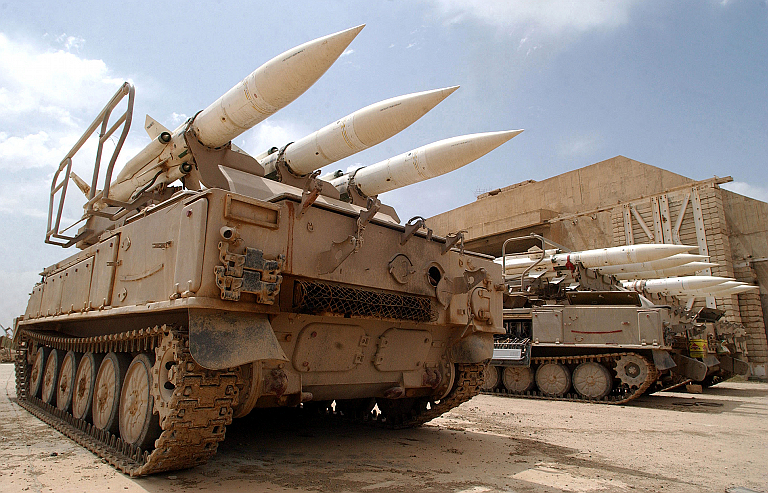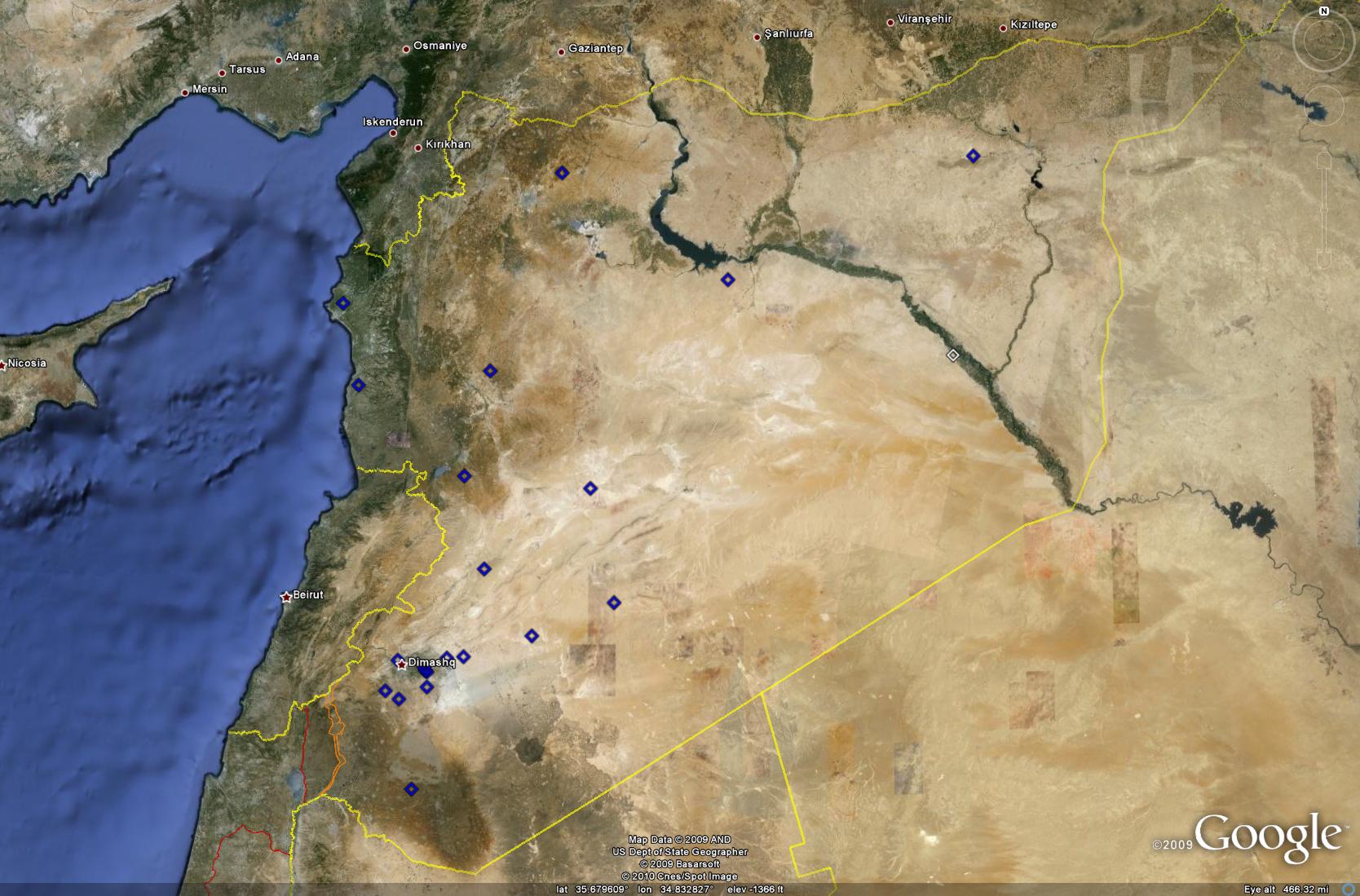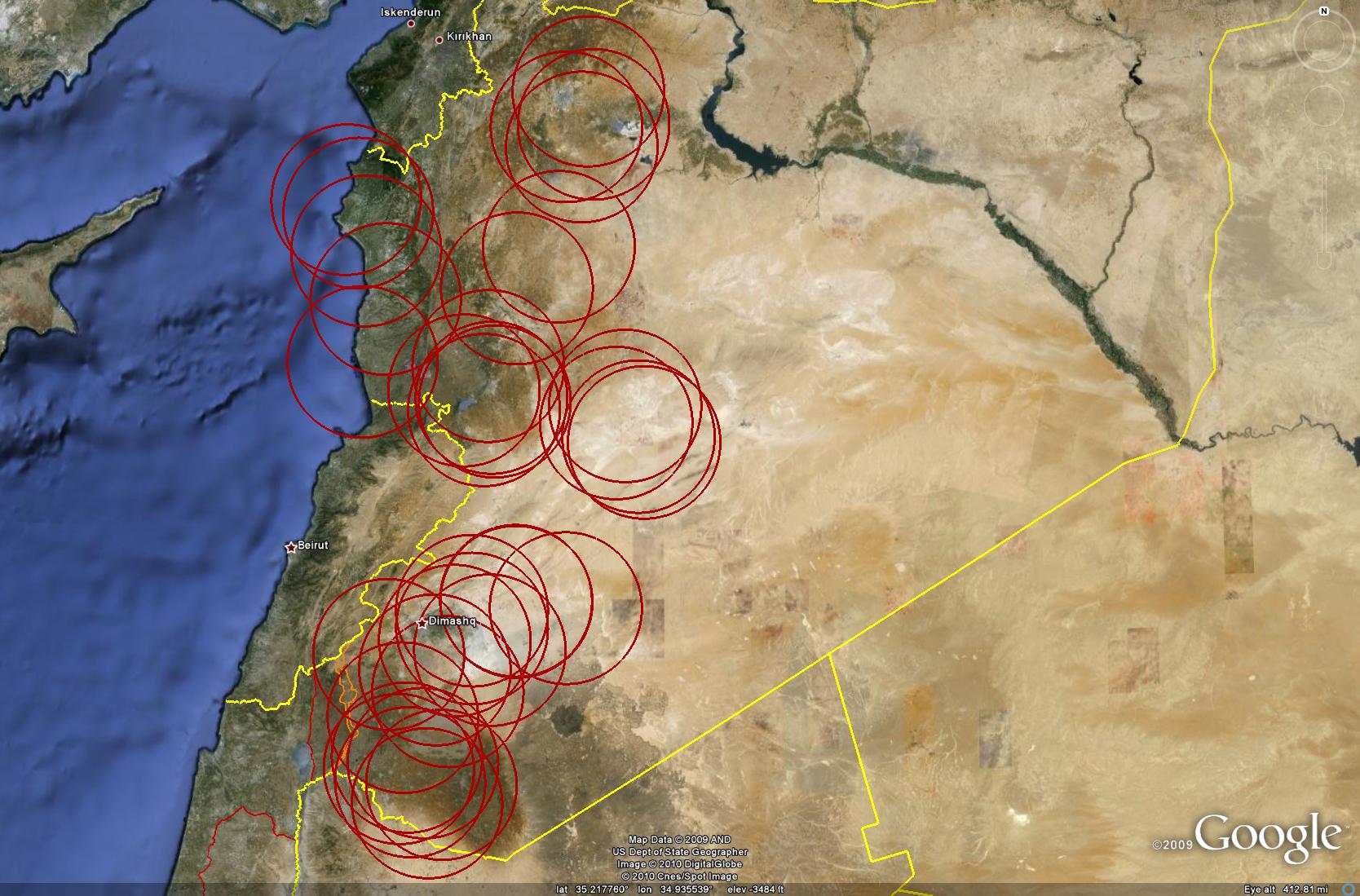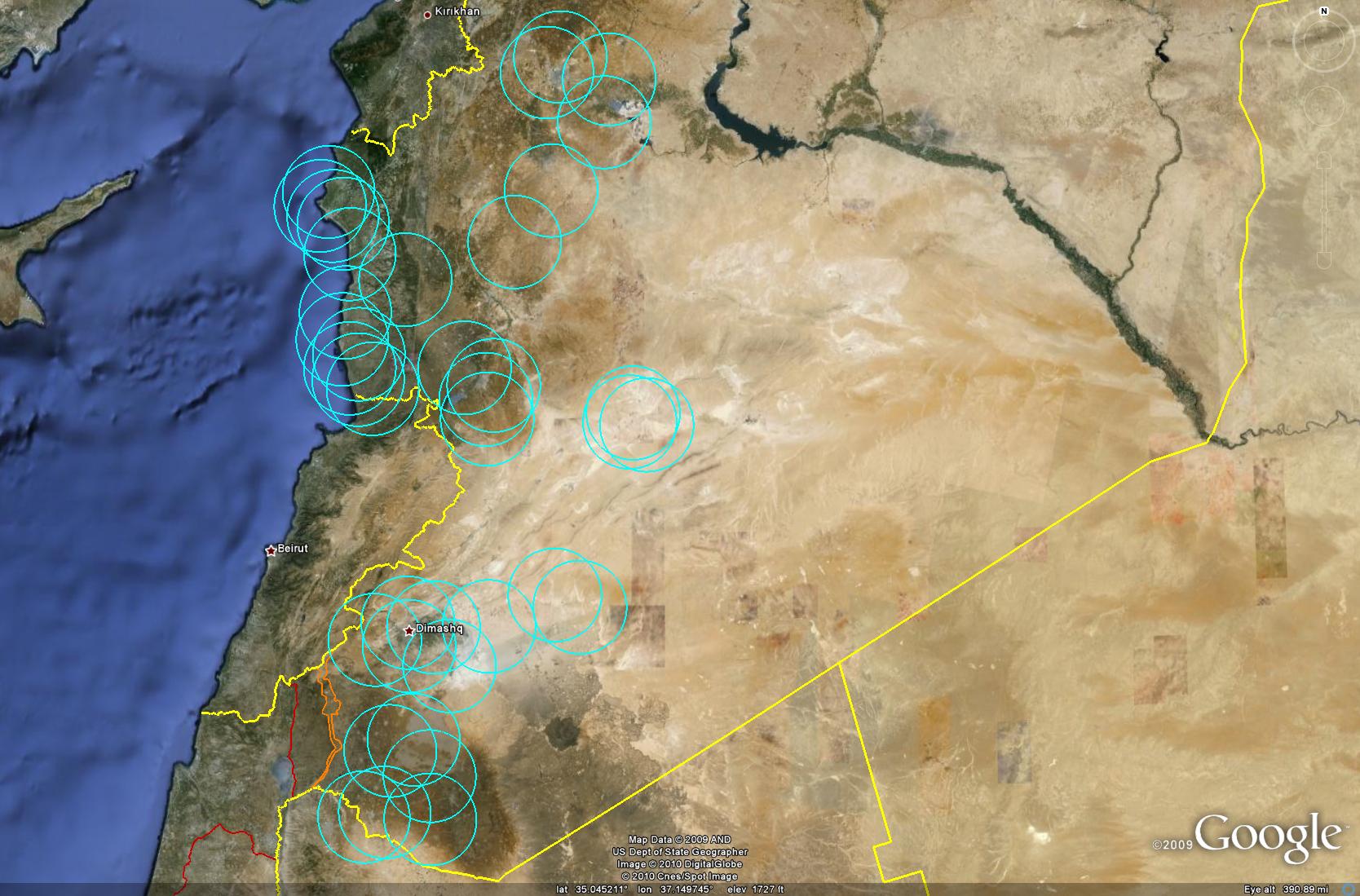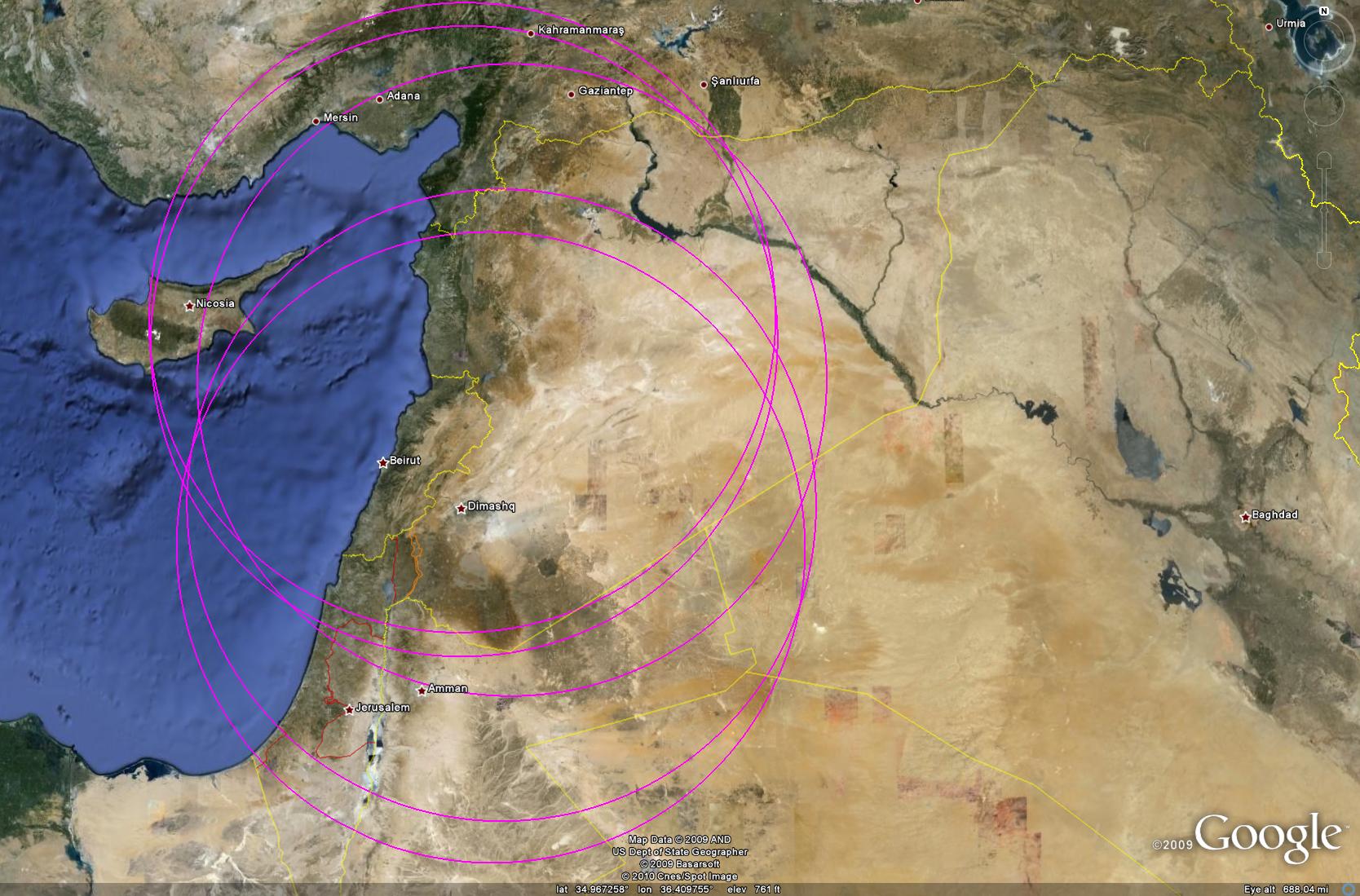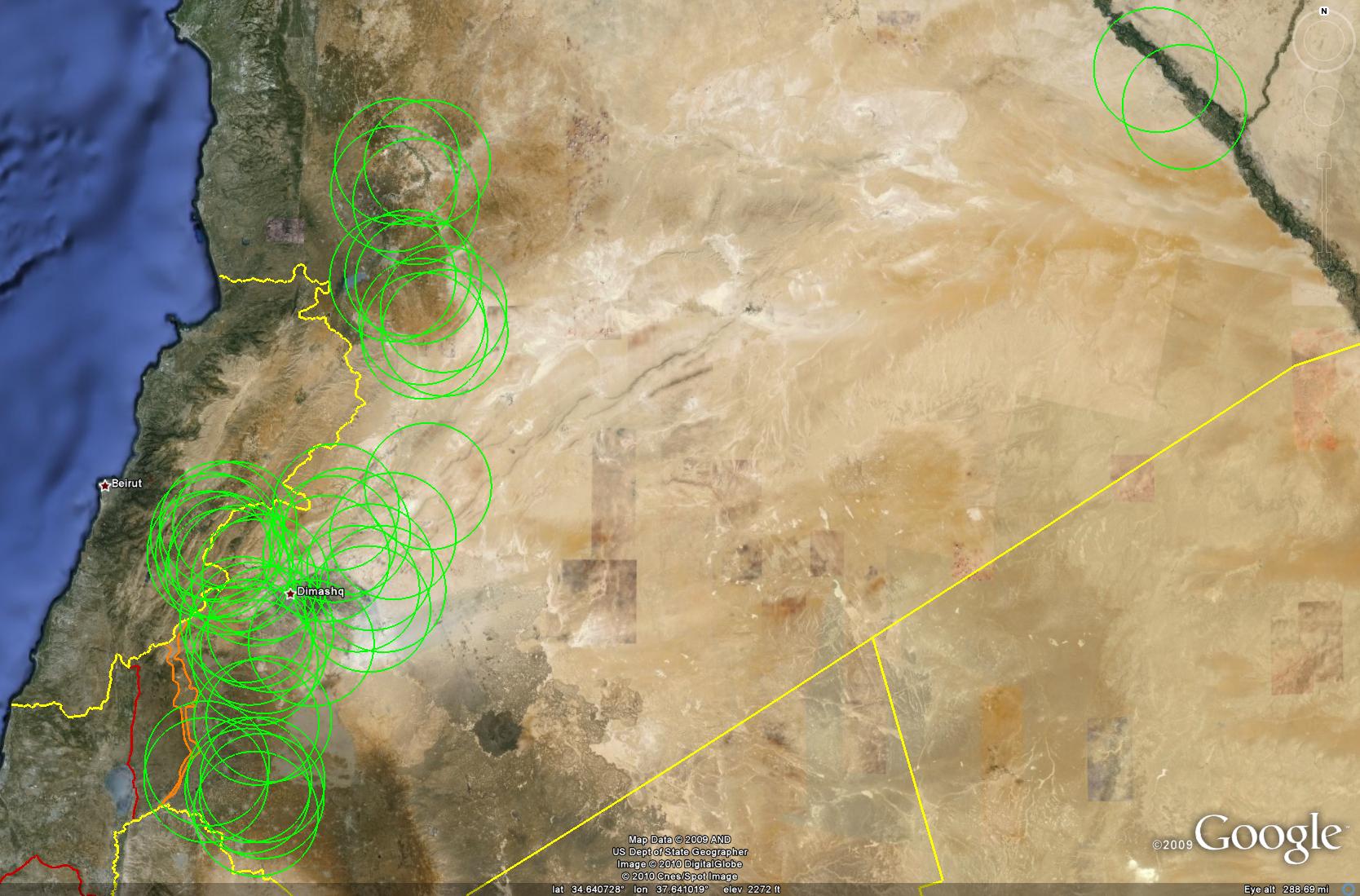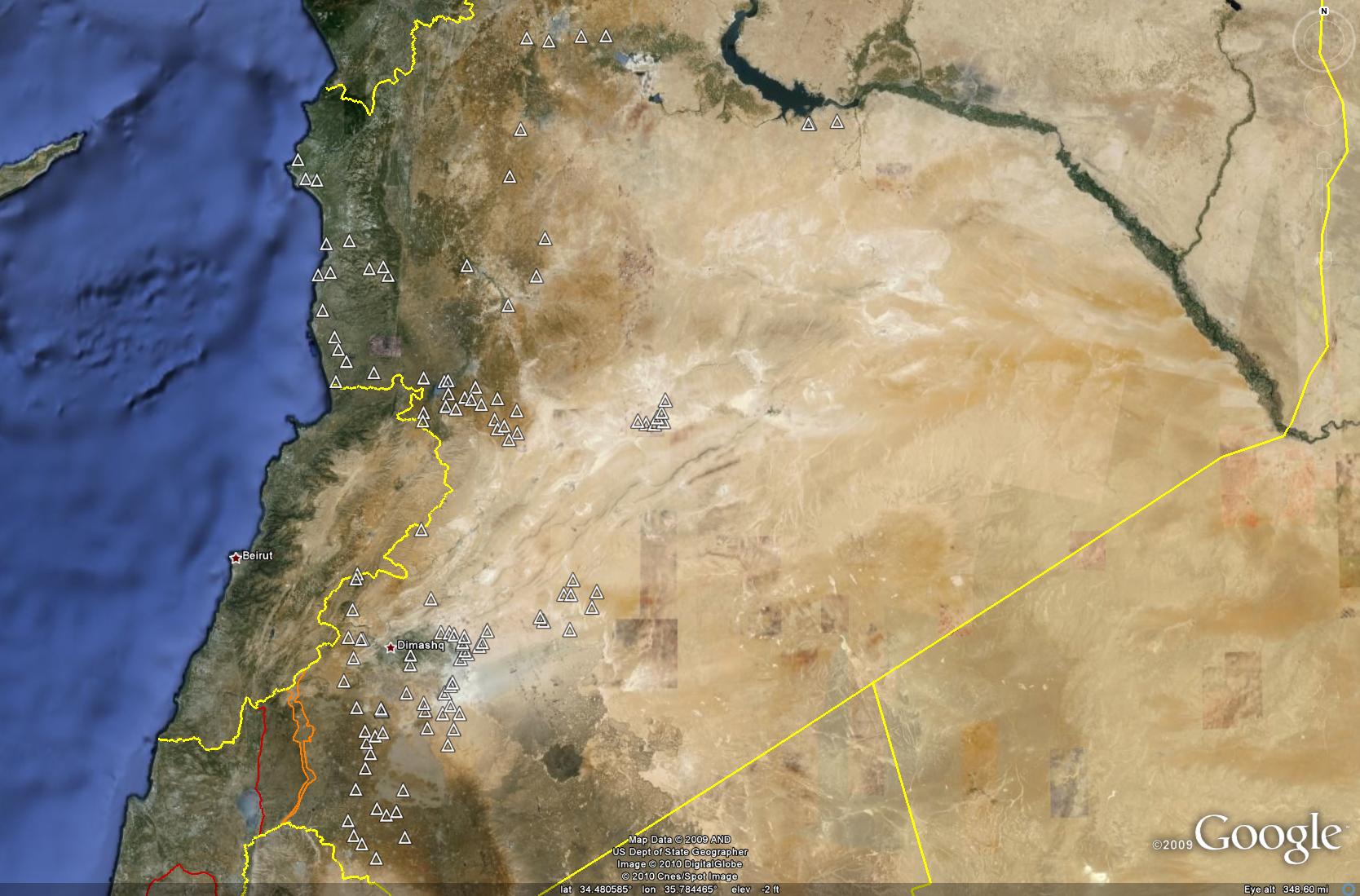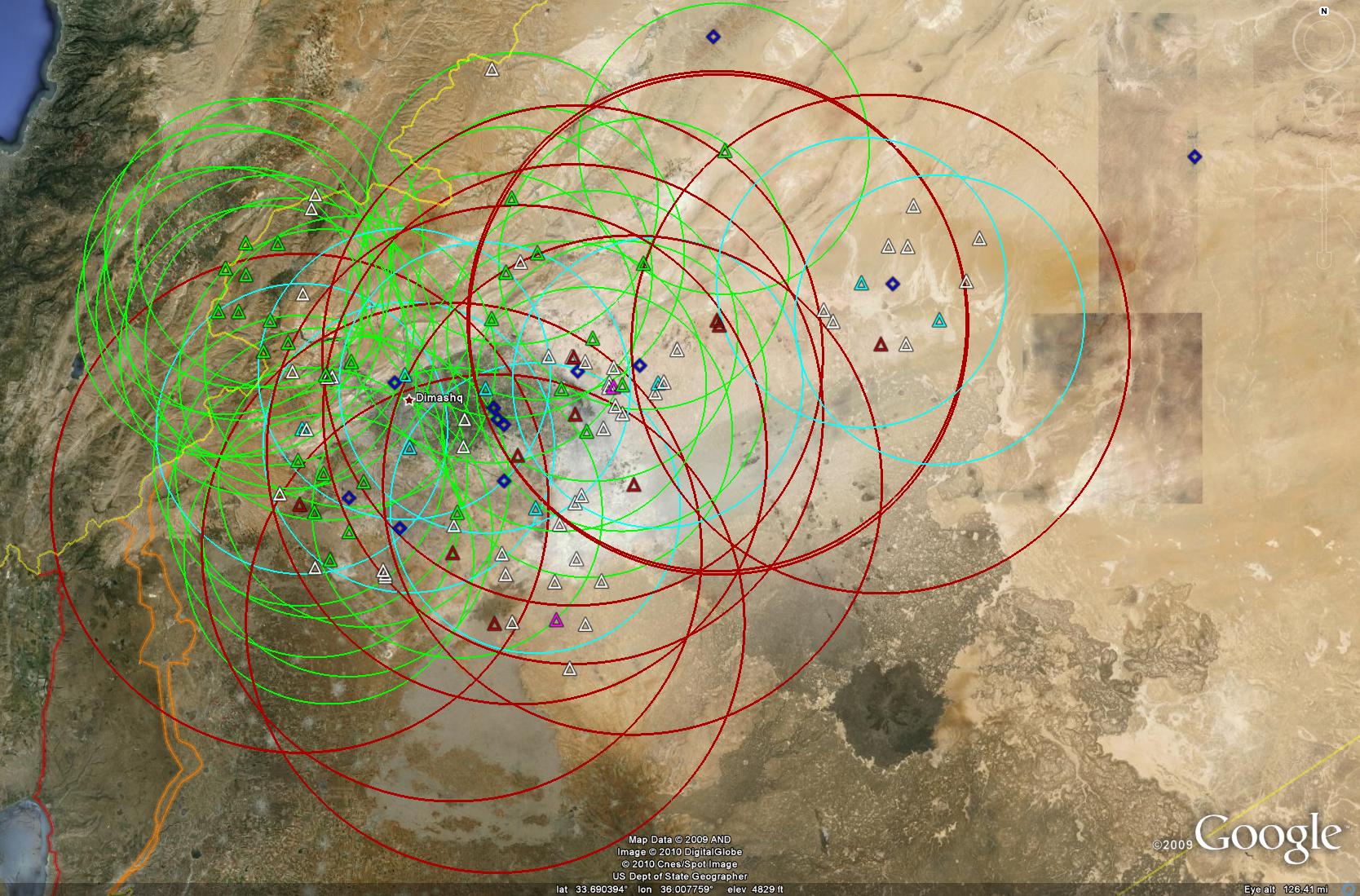Strategic
SAM
Defences
The Syrian strategic SAM
network relies primarily on Soviet-era systems. The following strategic
SAM systems are currently in service as part of the fixed air defense
network: S-75 (SA-2 GUIDELINE), S-125 (SA-3 GOA), and S-200 (SA-5
GAMMON). The 2K12 (SA-6 GAINFUL) tactical SAM systems is also employed
at a number of fixed sites to provide additional support to the
purpose-built strategic systems.
Currently, there are 131 active
SAM sites inside of Syria. The following image depicts the locations of
these sites. S-75 sites are red, S-125 sites are blue, S-200 sites are
purple, and 2K12 sites are green.
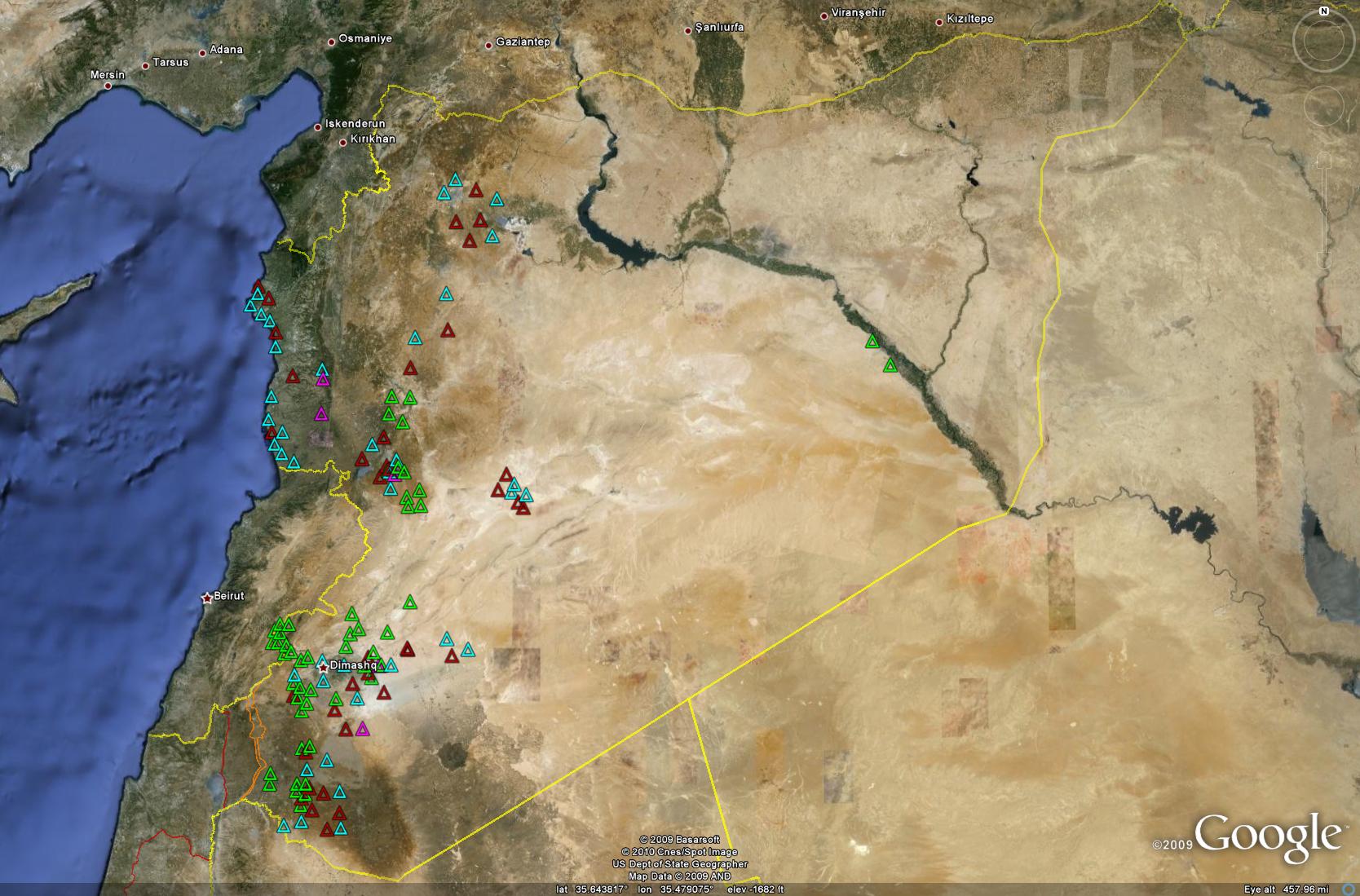
The
following image depicts the overall SAM coverage provided by Syrian air
defense sites. Using the same color scheme applied in the previous
image, S-75 range rings are red, S-125 rings are blue, S-200 rings are
purple, and 2K12 rings are green.
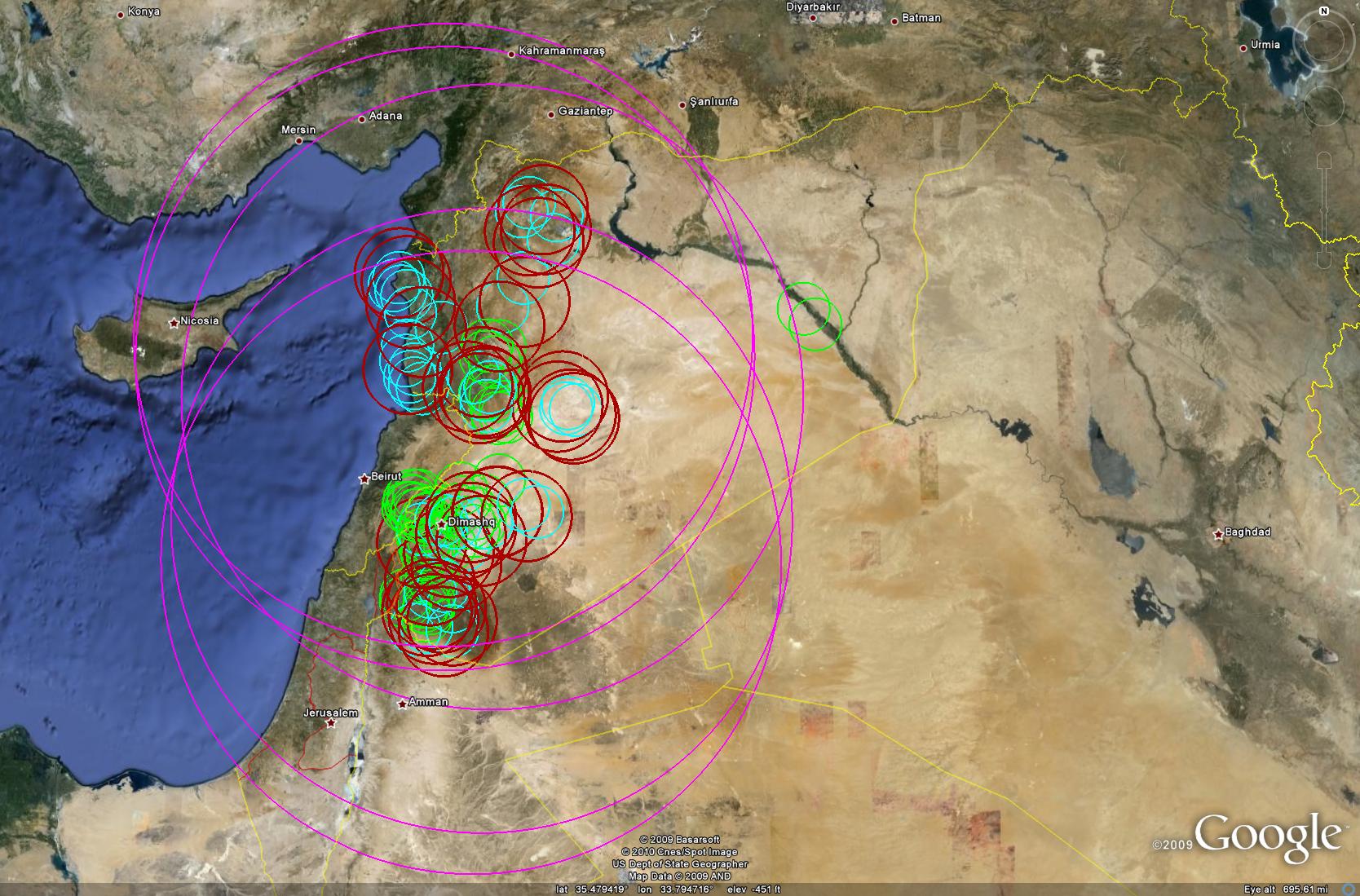
Early Warning /
Surveillance Coverage
Early
warning for the Syrian air defense network is handled by 22 Early
Warning radar
sites. One of these sites possesses a 36D6 TIN SHIELD EW radar
system. The majority of the remaining Early Warning sites employ
standard FSU Early Warning
systems, including the P-35/37 BAR LOCK, P-12/18 SPOON REST, PRV-16
THIN SKIN heightfinder, 5N87/P-80 BACK NET, and 5N84/P-14 TALL KING.
The following image depicts the locations of Syria's EW radar
facilities:
|
S-75 / SA-2
Guideline
There are currently 37 active
S-75 sites within
Syria. With one third of Syria's S-75 sites being operational, it would
be simple to conclude that the S-75 is no longer heavily relied upon.
However, given that the S-75 is still deployed in various key areas,
this would seem to be an illogical conclusion. The more likely scenario
is that early systems have exceeded their service lives and been
withdrawn, and other systems have perhaps been stored for future use or
simply withdrawn to downsize the network into a more financially
manageable operation.
The following image depicts the coverage provided by Syria's S-75 sites:
S-125 / SA-3 Goa
There
are currently 39 active S-125 sites within Syria. The S-125 appears to
be an extremely active system. Sixteen prepared S-75 and S-125 sites
have
seen S-125 batteries come and go since 2001, demonstrating Syria's
ability to periodically adjust its SAM deployments. Approximately half
of Syria's S-125 batteries are currently sited on prepared S-75
locations, a fact which demonstrates the importance of not only
identifying site layouts but the systems occupying said locations.
The following image depicts the coverage provided by Syria's S-125
sites:
S-200 / SA-5
Gammon
There
are currently 5 active S-200 sites within Syria. The S-200 provides
long-range barrier air defense along the western border and into the
Mediterranean.
The following image depicts the coverage provided by Syria's S-200
sites:
2K12 Kvadrat /
SA-6 Gainful
There
are currently 50 active 2K12 sites within Syria. Despite being a
tactical SAM system, emplacing 2K12 batteries at prepared sites allows
them to function as part of the overall strategic SAM network. Due to
their inherent mobility, these systems could be rapidly relocated
should the need arise.
The following image depicts the coverage provided by Syria's SA-6 sites:
Empty SAM Sites
There
are currently 120 unoccupied, prepared SAM sites inside Syria. These
sites have been identified as either S-75, S-125, S-200, or 2K12 sites,
based on their configurations, and can be broken down as follows: 80
S-75 sites, 16 S-125 sites, 2 S-200 sites, and 22 2K12 sites.
These
empty SAM sites can perform multiple tasks within the overall air
defense network. They can be employed as dispersal sites for existing
air defense assets, complicating enemy targeting. They can also be used
to deploy additional SAM systems currently held in storage if more air
defense assets are deemed necessary in a given sector.
An overview of empty Syrian SAM sites is provided in the following
image:
|
Strategic SAM Force
Capability
Syrian strategic
SAM deployment is concentrated in six areas. These areas are around the
cities of Hims, Halab, and Damascus, Tiyas air base, the Mediterranean
coastal area, and the area adjacent to the Golan Heights. These SAM
concentrations are emplaced to defend against obvious potential threat
ingress routes. The largest perceived threat to Syrian sovereign
airspace is Israeli Air Force activity. Syria enjoyed a relatively
equitable relationship with Iraq, and as such likely did not see a need
to deploy air defense assets in the eastern part of the nation. This
"empty" airspace could easily be patrolled by MiG-23, MiG-25, or MiG-29
interceptors if the need arose.
There are important issues with
the Syrian SAM network that need to be addressed. The main issue is the
nature of the SAM systems themselves. All of the SAM systems in the
Syrian inventory have a single-target engagement capability. Some of
the S-200 sites have been noted with multiple 5N62 SQUARE PAIR
engagement radars, allowing those sites to engage multiple targets (one
per engagement radar), but the S-75, S-125, and 2K12 sites can only
engage one target per site. This leaves the Syrian air defense network
susceptible to saturation.
Another issue is the employment of the
2K12 in a strategic role, tied to fixed sites to provide close-in
defense. The 2K12 has been captured and exploited thoroughly by both
the American
and Israeli militaries and as such cannot be counted on to reliably
defend against an airborne threat. The same could be said of the S-75
and S-125 SAM systems as well, of course, but the 2K12 suffers from the
additional drawback of being constrained to a fixed location. The 2K12
is most effective on the move, whereby it can catch opposing aircraft
off-guard by appearing in new locations that were previously
undocumented. This may be a part of the Syrian strategy, but for now,
the 2K12 remains a stationary target insofar as how it is currently
deployed.
Syrian reliance on aging and well-known Soviet-era
SAM systems is a serious defensive liability. This is certainly part of
the impetus behind Syria's current drive to purchase more advanced SAM
systems from Russia.
Another important issue to address is the
fact that there are two noticeable gaps in Syrian SAM coverage. While
these areas are in fact covered by S-200 sites, they lack any sort of
low-altitude coverage or close-in defense. Approximately midway between
Damascus and Hims, and midway between Al Lathqiyah and Halab, are large
gaps in the SAM coverage, areas where there are not even identified
empty sites where fixed systems such as the S-75 or S-125 could be
emplaced if need be. These gaps are not necessarily an invitation to
invasion, however, as key targets such as the capital are still heavily
defended.
Damascus
The first area to be examined
is the area surrounding the capital of Damascus. Damascus is defended
by ten S-75 sites, eight S-125 sites, and twenty-eight 2K12 sites. Two
of Syria's five active S-200 sites are also located in close vicinity
to the capital, as well as twelve early warning radar sites, including
the 36D6 site.
Forty-eight empty dispersal sites are also in the area, providing for
an increase in defensive capabilities should the need arise. SAM
coverage of the capital is relatively robust even without the addition
of further SAM sites, and careful placement of S-125 and 2K12 batteries
provides overlapping close-in defense in conjunction with the
longer-range S-75 sites.
The following image depicts the SAM coverage around Damascus:
The Southwest
Apart
from the capital, the most important piece of real estate in Syria may
be that in the southwest, adjacent to the Golan Heights. This area is
defended by seven S-75 sites, six S-125 sites, and nine 2K12 sites, and
supported by one identified early warning site. One of the S-200 sites
located
south of Damascus also can provide coverage of this area. There are
sixteen identified dispersal sites in the area, but the large
concentration of SAM systems provides a very well put together air
defense network over southwestern Syria without any further increases.
The large number of 2K12 sites is clearly meant to counter the threat
posed by Israeli Air Force fighter aircraft, the 2K12 being more
maneuverable and better suited to engaging fast jets than the more
strategically-oriented S-75 and S-125 systems.
The following image depicts the SAM coverage of southwestern Syria:
Mediterranean
Coast
The
Golan-area SAM network is clearly oriented to provide barrier air
defense against airborne threats ingressing from the west. The same
sort of barrier air defense network can be found along Syria's
Mediterranean coastline to the north. Extending from Al Lathqiyah to
Tartus, five S-75 and twelve S-125 sites provide air defense along
Syria's northwestern border with the sea, supported by two early
warning sites.
There are also two S-200 sites in the area to provide long-range air
defense over open water. Sixteen dispersal sites in the area are
situated to provide an increase in defensive capability.
The following image depicts the SAM coverage of Syria's northwestern
coastline:
Hims-Halab Line
There
is a second SAM barrier behind the coastal defenses, protecting the
area from Hims in the south to Halab in the north. The barrier consists
of eleven S-75 sites, ten S-125 sites, and eleven 2K12 sites, supported
by three early warning sites. An S-200 battery is positioned southeast
of Hims,
and there are thirty dispersal sites along the line, mostly
concentrated in the south around Hims.
The following image depicts the SAM coverage of the Hims-Halab belt:
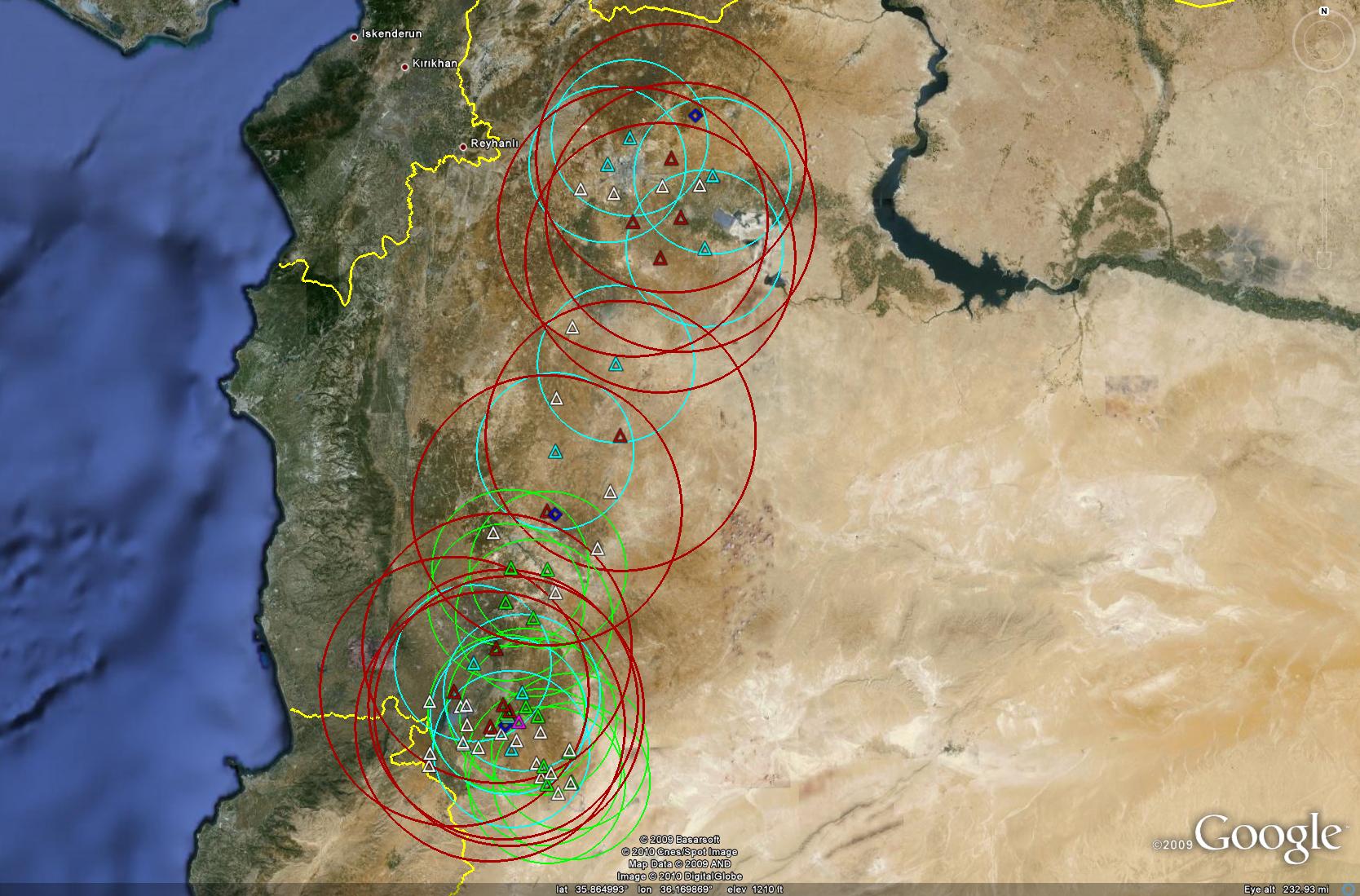
Tiyas AB
Tiyas
AB is defended by four S-75 and three S-125 sites, supported by an
early warning
site, and surrounded by seven dispersal sites available if necessary.
Air defenses surrounding Tiyas are not particularly robust when
compared to the rest of the network, but they do provide a heightened
degree of security and are overlapping and redundant to a limited
degree.
The following image depicts the SAM coverage around Tiyas AB:
|
![Home - Air Power Australia Website [Click for more ...]](APA/APA-Title-Main.png)
![Sukhoi PAK-FA and Flanker Index Page [Click for more ...]](APA/flanker.png)
![F-35 Joint Strike Fighter Index Page [Click for more ...]](APA/jsf.png)
![Weapons Technology Index Page [Click for more ...]](APA/weps.png)
![News and Media Related Material Index Page [Click for more ...]](APA/media.png)
![Surface to Air Missile Systems / Integrated Air Defence Systems Index Page [Click for more ...]](APA/sams-iads.png)
![Ballistic Missiles and Missile Defence Page [Click for more ...]](APA/msls-bmd.png)
![Air Power and National Military Strategy Index Page [Click for more ...]](APA/strategy.png)
![Military Aviation Historical Topics Index Page [Click for more ...]](APA/history.png)
![Intelligence, Surveillance and Reconnaissance and Network Centric Warfare Index Page [Click for more ...]](APA/isr-ncw.png)
![Information Warfare / Operations and Electronic Warfare Index Page [Click for more ...]](APA/iw.png)
![Systems and Basic Technology Index Page [Click for more ...]](APA/technology.png)
![Related Links Index Page [Click for more ...]](APA/links.png)
![Homepage of Australia's First Online Journal Covering Air Power Issues (ISSN 1832-2433) [Click for more ...]](APA/apa-analyses.png)
![Sukhoi PAK-FA and Flanker Index Page [Click for more ...]](APA/flanker.png)
![F-35 Joint Strike Fighter Index Page [Click for more ...]](APA/jsf.png)
![Weapons Technology Index Page [Click for more ...]](APA/weps.png)
![News and Media Related Material Index Page [Click for more ...]](APA/media.png)
![Surface to Air Missile Systems / Integrated Air Defence Systems Index Page [Click for more ...]](APA/sams-iads.png)
![Ballistic Missiles and Missile Defence Page [Click for more ...]](APA/msls-bmd.png)
![Air Power and National Military Strategy Index Page [Click for more ...]](APA/strategy.png)
![Military Aviation Historical Topics Index Page [Click for more ...]](APA/history.png)
![Information Warfare / Operations and Electronic Warfare Index Page [Click for more ...]](APA/iw.png)
![Systems and Basic Technology Index Page [Click for more ...]](APA/technology.png)
![Related Links Index Page [Click for more ...]](APA/links.png)
![Homepage of Australia's First Online Journal Covering Air Power Issues (ISSN 1832-2433) [Click for more ...]](APA/apa-analyses.png)
![F-111 Aardvark Index Page [Click for more ...]](APA/f-111.png)
![F/A-18 Hornet and Super Hornet Index Page [Click for more ...]](APA/fa-18a.png)
![Aerial Refuelling and Airlift Capabilities Index Page [Click for more ...]](APA/aar-lift.png)
![Directed Energy Weapons and Electromagnetic Bombs Index Page [Click for more ...]](APA/dew.png)
![Notices and Updates Index Page [Click for more ...]](APA/notices-128.png)
![APA NOTAM and Media Release Index Page [Click for more ...]](APA/notams-128.png)
![APA Research Activities and Policy / Technical Reports Index [Click for more ...]](APA/research-128.png)
![Search Air Power Australia Website [Click for more ...]](APA/search-128.png)
![Briefings and Submissions - Air Power Australia [Click for more ...]](APA/briefs-128.png)
![Air Power Australia Contacts [Click for more ...]](APA/contacts-128.png)
![Funding Air Power Australia [Click for more ...]](APA/funding-258.png)

